Network Protocols and SDLC: TCP Handshake, RAD, Agile Methods
VerifiedAdded on 2021/02/19
|6
|1613
|71
Homework Assignment
AI Summary
This assignment delves into the core concepts of network protocols and the Software Development Life Cycle (SDLC). It begins with an explanation of the 3-way handshake in TCP, detailing its importance in establishing reliable and secure communication. The assignment then explores the Rapid Application Development (RAD) model, outlining its advantages, such as flexibility and reduced project risk, and disadvantages, including its unsuitability for smaller projects and increased technical risks in certain scenarios. Furthermore, it examines the Agile methodology, highlighting its benefits like improved development processes and increased project transparency, while also addressing its limitations related to rigid client processes and unclear project requirements. The assignment also discusses scope creep in software development, explaining its causes and providing strategies for mitigation. Finally, it outlines various fact-finding techniques, such as interviews, questionnaires, and record inspections, used to gather requirements for new systems, particularly during the planning, requirement collection, and analysis phases. The assignment concludes by summarizing the key topics covered, providing a comprehensive overview of network protocols and SDLC principles.
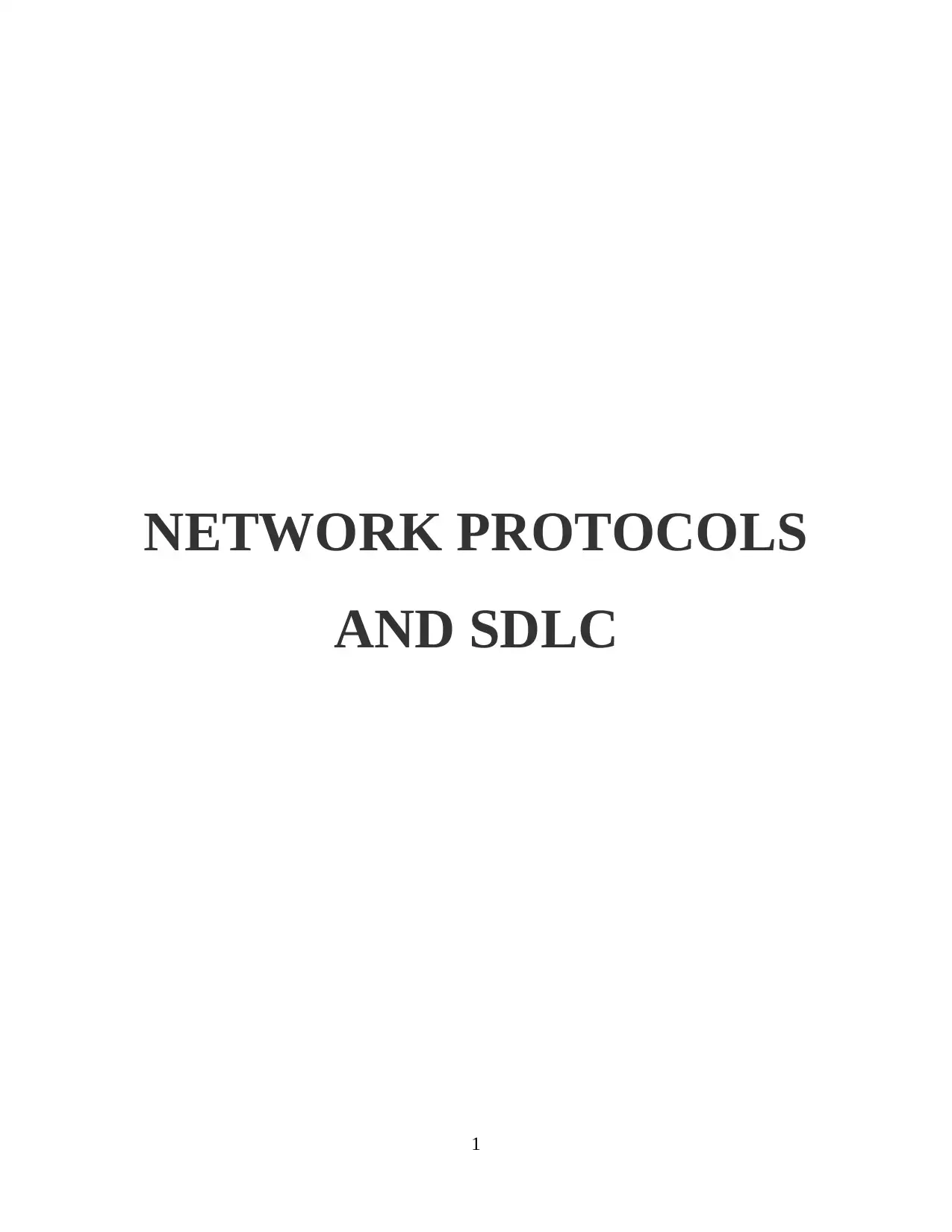
NETWORK PROTOCOLS
AND SDLC
1
AND SDLC
1
Paraphrase This Document
Need a fresh take? Get an instant paraphrase of this document with our AI Paraphraser
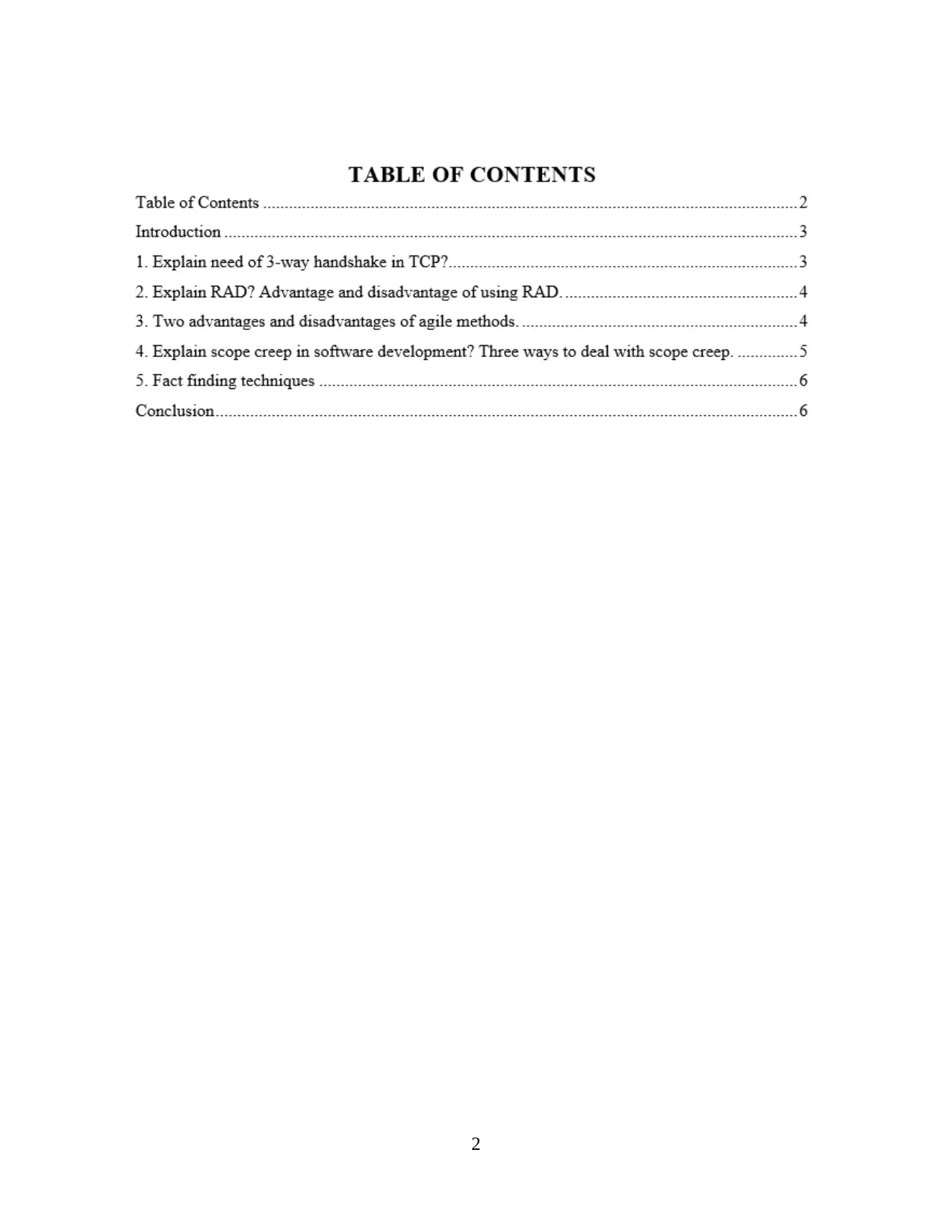
2
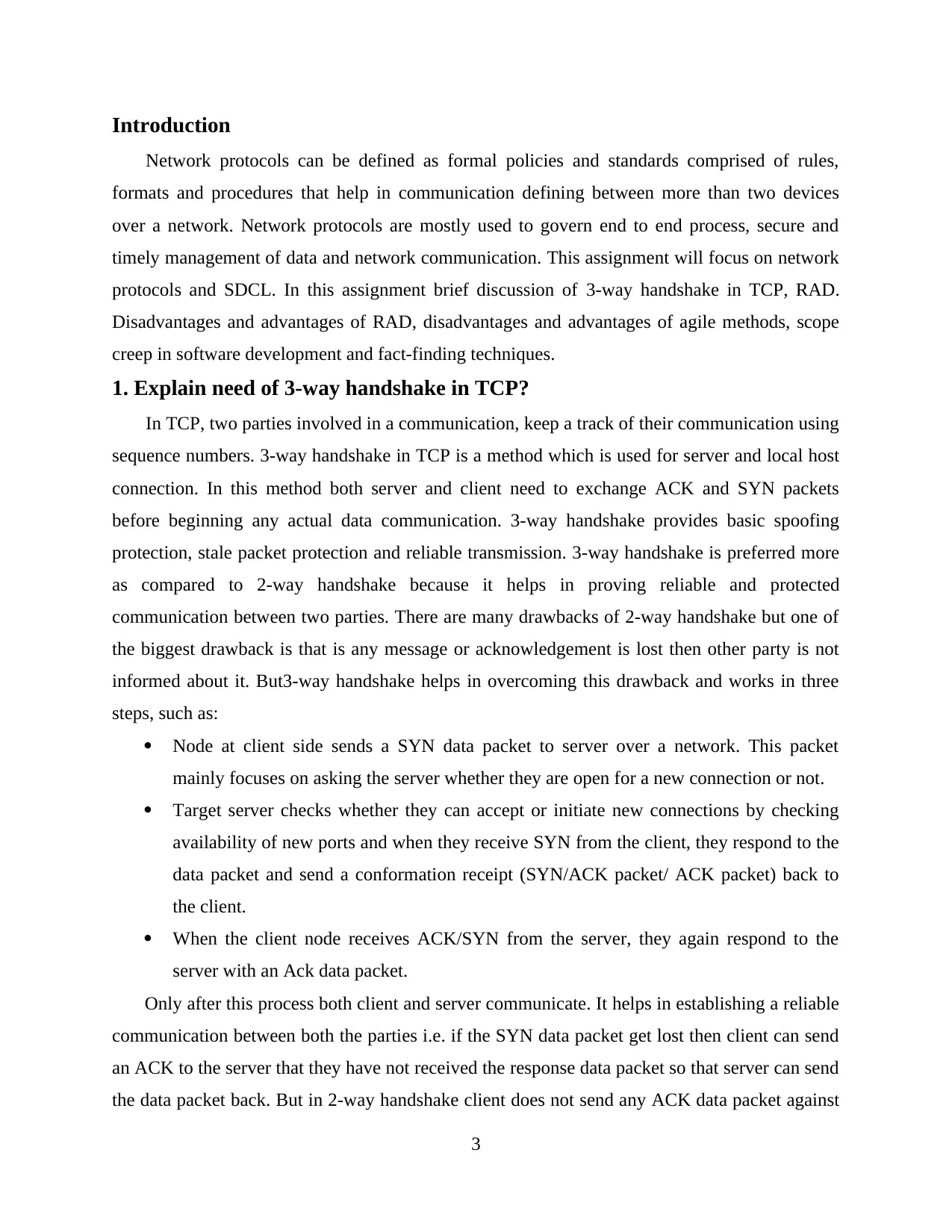
Introduction
Network protocols can be defined as formal policies and standards comprised of rules,
formats and procedures that help in communication defining between more than two devices
over a network. Network protocols are mostly used to govern end to end process, secure and
timely management of data and network communication. This assignment will focus on network
protocols and SDCL. In this assignment brief discussion of 3-way handshake in TCP, RAD.
Disadvantages and advantages of RAD, disadvantages and advantages of agile methods, scope
creep in software development and fact-finding techniques.
1. Explain need of 3-way handshake in TCP?
In TCP, two parties involved in a communication, keep a track of their communication using
sequence numbers. 3-way handshake in TCP is a method which is used for server and local host
connection. In this method both server and client need to exchange ACK and SYN packets
before beginning any actual data communication. 3-way handshake provides basic spoofing
protection, stale packet protection and reliable transmission. 3-way handshake is preferred more
as compared to 2-way handshake because it helps in proving reliable and protected
communication between two parties. There are many drawbacks of 2-way handshake but one of
the biggest drawback is that is any message or acknowledgement is lost then other party is not
informed about it. But3-way handshake helps in overcoming this drawback and works in three
steps, such as:
Node at client side sends a SYN data packet to server over a network. This packet
mainly focuses on asking the server whether they are open for a new connection or not.
Target server checks whether they can accept or initiate new connections by checking
availability of new ports and when they receive SYN from the client, they respond to the
data packet and send a conformation receipt (SYN/ACK packet/ ACK packet) back to
the client.
When the client node receives ACK/SYN from the server, they again respond to the
server with an Ack data packet.
Only after this process both client and server communicate. It helps in establishing a reliable
communication between both the parties i.e. if the SYN data packet get lost then client can send
an ACK to the server that they have not received the response data packet so that server can send
the data packet back. But in 2-way handshake client does not send any ACK data packet against
3
Network protocols can be defined as formal policies and standards comprised of rules,
formats and procedures that help in communication defining between more than two devices
over a network. Network protocols are mostly used to govern end to end process, secure and
timely management of data and network communication. This assignment will focus on network
protocols and SDCL. In this assignment brief discussion of 3-way handshake in TCP, RAD.
Disadvantages and advantages of RAD, disadvantages and advantages of agile methods, scope
creep in software development and fact-finding techniques.
1. Explain need of 3-way handshake in TCP?
In TCP, two parties involved in a communication, keep a track of their communication using
sequence numbers. 3-way handshake in TCP is a method which is used for server and local host
connection. In this method both server and client need to exchange ACK and SYN packets
before beginning any actual data communication. 3-way handshake provides basic spoofing
protection, stale packet protection and reliable transmission. 3-way handshake is preferred more
as compared to 2-way handshake because it helps in proving reliable and protected
communication between two parties. There are many drawbacks of 2-way handshake but one of
the biggest drawback is that is any message or acknowledgement is lost then other party is not
informed about it. But3-way handshake helps in overcoming this drawback and works in three
steps, such as:
Node at client side sends a SYN data packet to server over a network. This packet
mainly focuses on asking the server whether they are open for a new connection or not.
Target server checks whether they can accept or initiate new connections by checking
availability of new ports and when they receive SYN from the client, they respond to the
data packet and send a conformation receipt (SYN/ACK packet/ ACK packet) back to
the client.
When the client node receives ACK/SYN from the server, they again respond to the
server with an Ack data packet.
Only after this process both client and server communicate. It helps in establishing a reliable
communication between both the parties i.e. if the SYN data packet get lost then client can send
an ACK to the server that they have not received the response data packet so that server can send
the data packet back. But in 2-way handshake client does not send any ACK data packet against
3
⊘ This is a preview!⊘
Do you want full access?
Subscribe today to unlock all pages.

Trusted by 1+ million students worldwide
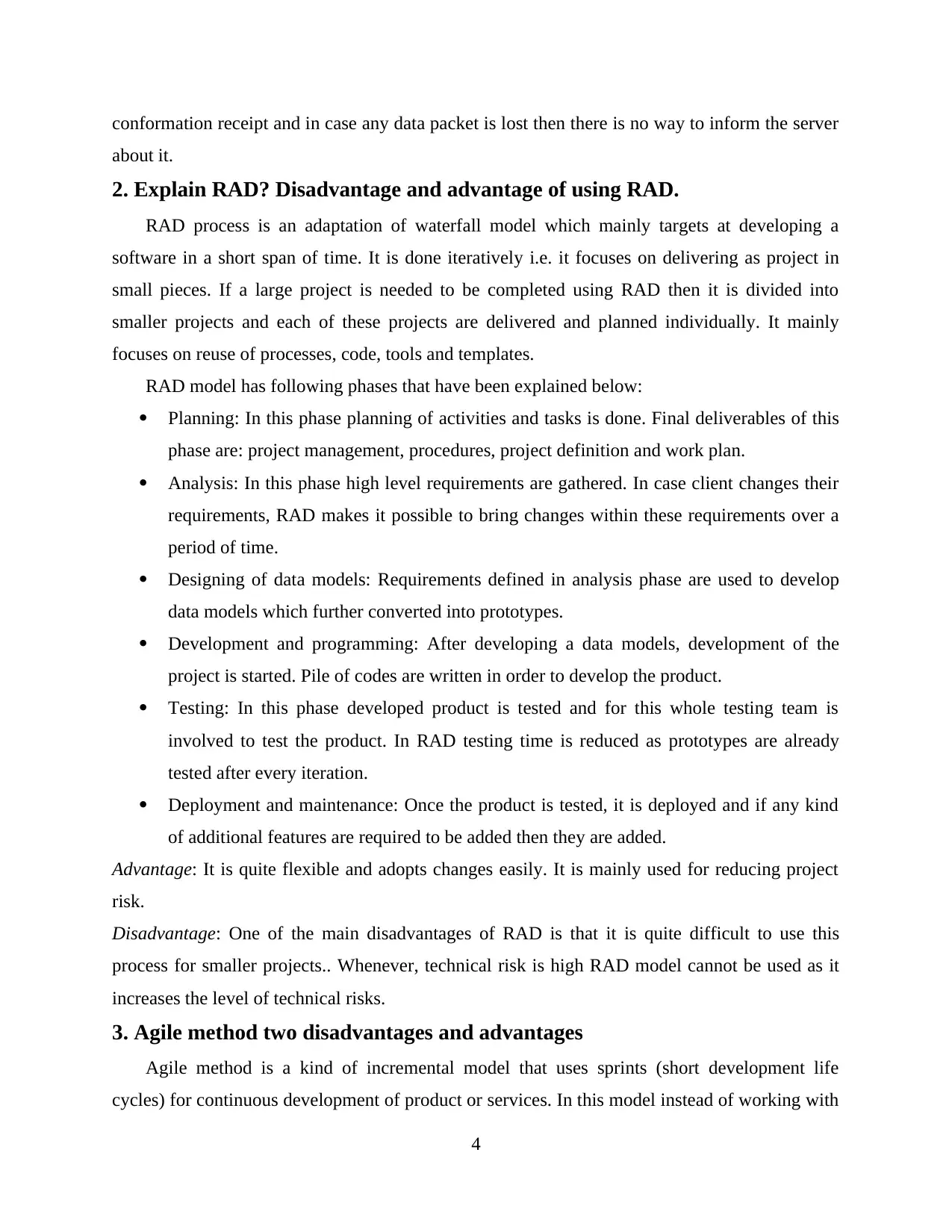
conformation receipt and in case any data packet is lost then there is no way to inform the server
about it.
2. Explain RAD? Disadvantage and advantage of using RAD.
RAD process is an adaptation of waterfall model which mainly targets at developing a
software in a short span of time. It is done iteratively i.e. it focuses on delivering as project in
small pieces. If a large project is needed to be completed using RAD then it is divided into
smaller projects and each of these projects are delivered and planned individually. It mainly
focuses on reuse of processes, code, tools and templates.
RAD model has following phases that have been explained below:
Planning: In this phase planning of activities and tasks is done. Final deliverables of this
phase are: project management, procedures, project definition and work plan.
Analysis: In this phase high level requirements are gathered. In case client changes their
requirements, RAD makes it possible to bring changes within these requirements over a
period of time.
Designing of data models: Requirements defined in analysis phase are used to develop
data models which further converted into prototypes.
Development and programming: After developing a data models, development of the
project is started. Pile of codes are written in order to develop the product.
Testing: In this phase developed product is tested and for this whole testing team is
involved to test the product. In RAD testing time is reduced as prototypes are already
tested after every iteration.
Deployment and maintenance: Once the product is tested, it is deployed and if any kind
of additional features are required to be added then they are added.
Advantage: It is quite flexible and adopts changes easily. It is mainly used for reducing project
risk.
Disadvantage: One of the main disadvantages of RAD is that it is quite difficult to use this
process for smaller projects.. Whenever, technical risk is high RAD model cannot be used as it
increases the level of technical risks.
3. Agile method two disadvantages and advantages
Agile method is a kind of incremental model that uses sprints (short development life
cycles) for continuous development of product or services. In this model instead of working with
4
about it.
2. Explain RAD? Disadvantage and advantage of using RAD.
RAD process is an adaptation of waterfall model which mainly targets at developing a
software in a short span of time. It is done iteratively i.e. it focuses on delivering as project in
small pieces. If a large project is needed to be completed using RAD then it is divided into
smaller projects and each of these projects are delivered and planned individually. It mainly
focuses on reuse of processes, code, tools and templates.
RAD model has following phases that have been explained below:
Planning: In this phase planning of activities and tasks is done. Final deliverables of this
phase are: project management, procedures, project definition and work plan.
Analysis: In this phase high level requirements are gathered. In case client changes their
requirements, RAD makes it possible to bring changes within these requirements over a
period of time.
Designing of data models: Requirements defined in analysis phase are used to develop
data models which further converted into prototypes.
Development and programming: After developing a data models, development of the
project is started. Pile of codes are written in order to develop the product.
Testing: In this phase developed product is tested and for this whole testing team is
involved to test the product. In RAD testing time is reduced as prototypes are already
tested after every iteration.
Deployment and maintenance: Once the product is tested, it is deployed and if any kind
of additional features are required to be added then they are added.
Advantage: It is quite flexible and adopts changes easily. It is mainly used for reducing project
risk.
Disadvantage: One of the main disadvantages of RAD is that it is quite difficult to use this
process for smaller projects.. Whenever, technical risk is high RAD model cannot be used as it
increases the level of technical risks.
3. Agile method two disadvantages and advantages
Agile method is a kind of incremental model that uses sprints (short development life
cycles) for continuous development of product or services. In this model instead of working with
4
Paraphrase This Document
Need a fresh take? Get an instant paraphrase of this document with our AI Paraphraser

the employees, project team directly works with the client as it becomes easy for the team to
understand customer’s goal and provide solution in a fast and incremental way.
Agile method two disadvantages and advantages are:
Advantages:
One of the main advantages of agile methods is that it helps in improving development
process. It helps in easily identify and correct problems or defects. So that better output
can be provided in a short period of time called sprints.
Another advantage of agile methods is that it helps in increasing the overall flexibility of
the project and also increases transparency within the project.
Disadvantages:
Whenever client follows a rigid method or process it becomes difficult to implement
agile methodology.
Project can easily get off the track if customer is not clear of their project requirements.
4. Explain scope creep in software development and ways in which scope
creep can be dealt with.
Scope creep in project management refers to changes, uncontrolled or continuous growth in
project scope after beginning of a project. It mainly occurs when project scope is not defined
properly or is not controlled or documented in a proper manner.
There are various ways through which scope creep can be controlled, such as:
By documenting all the requirements scope creep can be avoided. By talking to all the
project stakeholders’ requirements of the project can be identified in a better manner.
By making a better change control process where all the changes will be identified,
reviews, accepted or rejected. If approved then it is incorporated in the project plan.
Creating a clear project schedule can also help in avoiding scope creep. Using
requirements, a detailed task list can be created, based on which project schedule can be
created. It will help in cross checking whether all the requirements of the project have
been covered or not.
It is important to check whether all the requirements of the client/customer are properly
understood by the team members or not. It will help in verifying scope of the project with
the stakeholders.
5
understand customer’s goal and provide solution in a fast and incremental way.
Agile method two disadvantages and advantages are:
Advantages:
One of the main advantages of agile methods is that it helps in improving development
process. It helps in easily identify and correct problems or defects. So that better output
can be provided in a short period of time called sprints.
Another advantage of agile methods is that it helps in increasing the overall flexibility of
the project and also increases transparency within the project.
Disadvantages:
Whenever client follows a rigid method or process it becomes difficult to implement
agile methodology.
Project can easily get off the track if customer is not clear of their project requirements.
4. Explain scope creep in software development and ways in which scope
creep can be dealt with.
Scope creep in project management refers to changes, uncontrolled or continuous growth in
project scope after beginning of a project. It mainly occurs when project scope is not defined
properly or is not controlled or documented in a proper manner.
There are various ways through which scope creep can be controlled, such as:
By documenting all the requirements scope creep can be avoided. By talking to all the
project stakeholders’ requirements of the project can be identified in a better manner.
By making a better change control process where all the changes will be identified,
reviews, accepted or rejected. If approved then it is incorporated in the project plan.
Creating a clear project schedule can also help in avoiding scope creep. Using
requirements, a detailed task list can be created, based on which project schedule can be
created. It will help in cross checking whether all the requirements of the project have
been covered or not.
It is important to check whether all the requirements of the client/customer are properly
understood by the team members or not. It will help in verifying scope of the project with
the stakeholders.
5
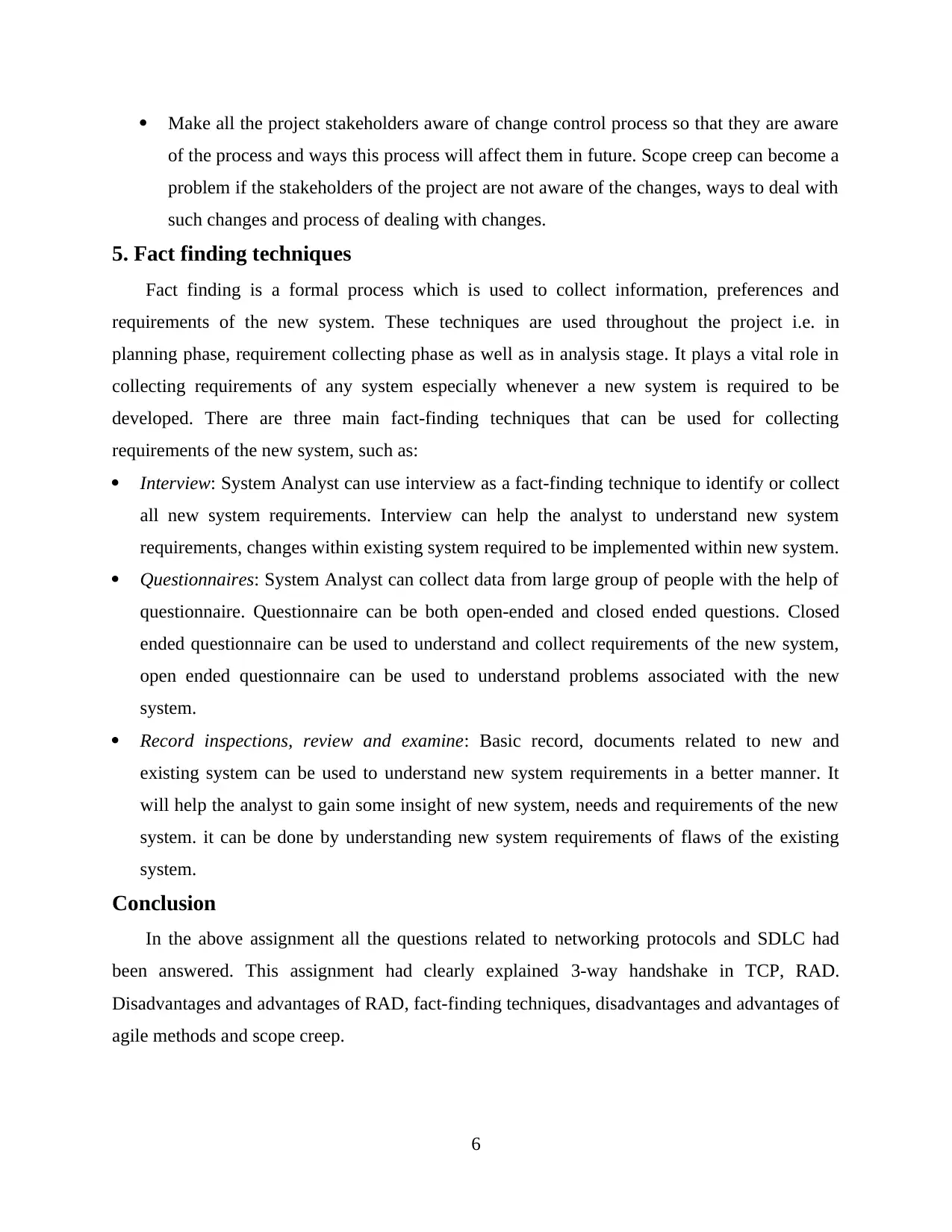
Make all the project stakeholders aware of change control process so that they are aware
of the process and ways this process will affect them in future. Scope creep can become a
problem if the stakeholders of the project are not aware of the changes, ways to deal with
such changes and process of dealing with changes.
5. Fact finding techniques
Fact finding is a formal process which is used to collect information, preferences and
requirements of the new system. These techniques are used throughout the project i.e. in
planning phase, requirement collecting phase as well as in analysis stage. It plays a vital role in
collecting requirements of any system especially whenever a new system is required to be
developed. There are three main fact-finding techniques that can be used for collecting
requirements of the new system, such as:
Interview: System Analyst can use interview as a fact-finding technique to identify or collect
all new system requirements. Interview can help the analyst to understand new system
requirements, changes within existing system required to be implemented within new system.
Questionnaires: System Analyst can collect data from large group of people with the help of
questionnaire. Questionnaire can be both open-ended and closed ended questions. Closed
ended questionnaire can be used to understand and collect requirements of the new system,
open ended questionnaire can be used to understand problems associated with the new
system.
Record inspections, review and examine: Basic record, documents related to new and
existing system can be used to understand new system requirements in a better manner. It
will help the analyst to gain some insight of new system, needs and requirements of the new
system. it can be done by understanding new system requirements of flaws of the existing
system.
Conclusion
In the above assignment all the questions related to networking protocols and SDLC had
been answered. This assignment had clearly explained 3-way handshake in TCP, RAD.
Disadvantages and advantages of RAD, fact-finding techniques, disadvantages and advantages of
agile methods and scope creep.
6
of the process and ways this process will affect them in future. Scope creep can become a
problem if the stakeholders of the project are not aware of the changes, ways to deal with
such changes and process of dealing with changes.
5. Fact finding techniques
Fact finding is a formal process which is used to collect information, preferences and
requirements of the new system. These techniques are used throughout the project i.e. in
planning phase, requirement collecting phase as well as in analysis stage. It plays a vital role in
collecting requirements of any system especially whenever a new system is required to be
developed. There are three main fact-finding techniques that can be used for collecting
requirements of the new system, such as:
Interview: System Analyst can use interview as a fact-finding technique to identify or collect
all new system requirements. Interview can help the analyst to understand new system
requirements, changes within existing system required to be implemented within new system.
Questionnaires: System Analyst can collect data from large group of people with the help of
questionnaire. Questionnaire can be both open-ended and closed ended questions. Closed
ended questionnaire can be used to understand and collect requirements of the new system,
open ended questionnaire can be used to understand problems associated with the new
system.
Record inspections, review and examine: Basic record, documents related to new and
existing system can be used to understand new system requirements in a better manner. It
will help the analyst to gain some insight of new system, needs and requirements of the new
system. it can be done by understanding new system requirements of flaws of the existing
system.
Conclusion
In the above assignment all the questions related to networking protocols and SDLC had
been answered. This assignment had clearly explained 3-way handshake in TCP, RAD.
Disadvantages and advantages of RAD, fact-finding techniques, disadvantages and advantages of
agile methods and scope creep.
6
⊘ This is a preview!⊘
Do you want full access?
Subscribe today to unlock all pages.

Trusted by 1+ million students worldwide
1 out of 6
Related Documents
Your All-in-One AI-Powered Toolkit for Academic Success.
+13062052269
info@desklib.com
Available 24*7 on WhatsApp / Email
![[object Object]](/_next/static/media/star-bottom.7253800d.svg)
Unlock your academic potential
Copyright © 2020–2025 A2Z Services. All Rights Reserved. Developed and managed by ZUCOL.


